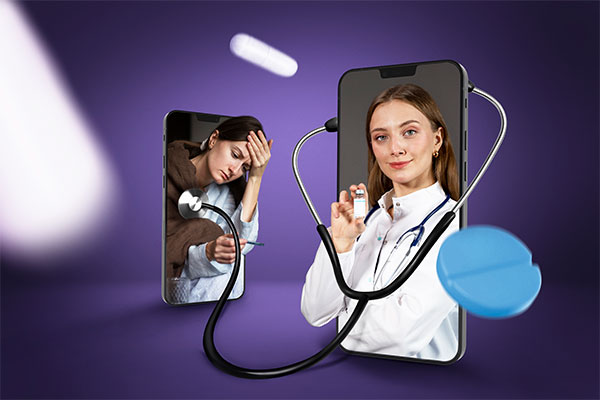Telemedicine is a method of providing medical care remotely, usually through video chat. It can include everything from conducting medical visits over the computer to monitoring patients’ vital signs remotely to sharing information between different providers. Telemedicine has become essential during the Covid-19 pandemic, as it offers convenience, safety, and accessibility for both patients and providers. However, telemedicine faces challenges like regulatory barriers, technical issues, and patient acceptance. In this article, we will explore the current state of telemedicine, the future trends that will shape the industry, and the opportunities that telemedicine can offer for improving health outcomes, access, and affordability.
The current state of telemedicine
Telemedicine has grown significantly over the last decade, as more healthcare providers and patients have adopted digital technologies to deliver and receive health care. According to a report by Harvard Business Review, 76 percent of hospitals in the U.S. connect doctors and patients remotely via telehealth, up from 35 percent a decade ago. Telemedicine usage in the U.S. peaked in April 2020, during the first surge of Covid-19 cases, accounting for 69 percent of doctor-patient visits. Similar patterns have been seen across Europe and Asia over the past two years.
Telemedicine offers a range of benefits for both patients and providers, such as:
- Reducing expensive and unnecessary trips to the emergency room
- Improving preventive medicine, care coordination, and chronic disease management
- Increasing patient satisfaction and engagement
- Enhancing access to care for people with mobility limitations or those in rural or underserved areas
- Lowering healthcare costs by increasing efficiency and reducing hospitalizations
However, telemedicine also faces some challenges, such as:
- Regulatory barriers that limit reimbursement, licensing, and credentialing of telehealth services
- Technical issues that affect the quality and reliability of telehealth platforms
- Patient acceptance may vary depending on age, education, income, and health literacy
- Clinical limitations that prevent physical examination or diagnosis of certain conditions via telehealth
Future trends of telemedicine
Despite these challenges, telemedicine will continue growing and evolving in the next few years as new technologies, innovations, and opportunities emerge. Some of the future trends that will shape the telemedicine industry are:
- Artificial intelligence (AI) and machine learning (ML) can enhance diagnosis, treatment, and decision-making via telehealth
- Wearable devices and sensors that can monitor patients’ vital signs and symptoms remotely and provide real-time feedback
- Blockchain technology can secure and streamline data sharing and transactions between different providers and patients
- Virtual reality (VR) and augmented reality (AR) can create immersive and interactive experiences for patients and providers via telehealth
- 5G network that can improve the speed, bandwidth, and connectivity of telehealth platforms
Opportunities for telemedicine
Telemedicine can improve health outcomes, access, and affordability for patients and providers across different settings and specialities. Some of the opportunities for telemedicine are:
- Primary care: Telemedicine can provide convenient and timely access to direct care services for routine check-ups, chronic disease management, medication management, and referrals.
- Mental health: Telemedicine can offer confidential and stigma-free access to mental health services such as psychotherapy, counselling, and medication management.
- Physical therapy: Telemedicine can enable remote assessment, guidance, and monitoring of physical therapy exercises for patients recovering from injuries or surgeries.
- Emergency care: Telemedicine can facilitate triage, diagnosis, and treatment of urgent conditions such as stroke, heart attack, or trauma via video conferencing or mobile applications.
- Specialty care: Telemedicine can expand access to specialty care services such as dermatology, cardiology, or oncology for patients who live in remote areas or have limited transportation options.
Conclusion
Telemedicine is transforming the healthcare industry by offering remote medical care and consultation through technology. It has become essential during the Covid-19 pandemic, as it provides convenience, safety, and accessibility for both patients and providers. However, telemedicine faces challenges like regulatory barriers, technical issues, and patient acceptance. Telemedicine will grow and evolve in the next few years as new technologies, innovations, and opportunities emerge. Telemedicine can improve health outcomes, access, and affordability for patients and providers across different settings and specialities. Telemedicine is not a replacement for in-person care but a complement that can enhance the quality and efficiency of healthcare delivery. By embracing telemedicine, patients and providers can benefit from the convenience, safety, and accessibility that it offers.
If you have any questions regarding telemedicine, feel free to contact Dr. Erum Jiva via email at info@atoz.healthcare or call us at 352-3045466
Disclaimer: Above information is subject to change and represent the views of the author. It is shared for educational purposes only. Readers are advised to use their own judgement and seek specific professional advice before making any decision. A to Z Healthcare is not liable for any actions taken by reader based on the information shared in this article. You may consult with us before using this information for any purpose.











